Player Profile: Gio Reyna
Gio Reyna has recently entered the stage of professional football at German side Borussia Dortmund. What makes him special?
The young American caught coach Favre’s eye quickly. In the winter break, the Swiss coach decided to call the former U19-player up to the first team. While many expected him to occasionally get a few minutes, he made his debut directly in the first game against FC Augsburg. Ever since, Reyna has collected 120 playing minutes in eight appearances. In several games he became Favre’s first substitute to change the odds of a game in its final phase. And indeed, as we will see he did make an impact.
Considering his recent performances and rapid development, many see in him the next huge talent in the Dortmund squad as well as the next top prospect of U.S. football after Christian Pulisic. In this article we will examine Reyna’s recent development, look at his current and potential future roll and not least have a deeper look at the value, with its strengths and weaknesses, the young American brings to his team.
Reyna’s earliest steps
“He used to dominate at U9s soccer in the park, when he was five.” – Claudio Reyna
With 30 minutes into the session, Jack Reyna turned to his father Claudio Reyna, and said: “Dad, Gio is the best player here by far.” Giovanni was nine years old during this try-out. What is remarkable at hindsight is that they didn’t watch him playing football but basketball.
A supremely gifted sportsman from an early age, Giovanni (aka Gio) Reyna is considered one of U.S.’ most promising football prospect. Born in England and coming to live in the States in 2007, Gio is the son of former American internationals Danielle and Claudio Reyna. While his mother won a handful of caps for the USA, his father is a USMNT icon and captain, with 112 appearances, three World Cups and the first American captain of a European team. After a successful playing career he was appointed sporting director of New York City FC. It was at this club, where Gio Reyna made first steps after he joined in 2015 at 13 and eventually came through the ranks. In tournaments such as the U17 Generation Adidas Cup where he was named player of the tournament at just 14 his talent soon shone through. The prodigious son confirmed his earlier performances in a strong 2017/18 campaign with NYCFC: He scored 13 goals in 17 appearances.
On a national level, Reyna played a starring role for the U.S. at several tournaments. On his international debut in April 2016, the American, then just 13, represented the U-15 team against Uruguay. Close to the end of the first half, he showed his determination beyond his years. Brought down by a defender, Reyna fell to the ground, somehow vaulted back up to his feet, beat two more defenders before coolly slotting past the goalkeeper for 2-0. Moreover, his four goals and four assists contributed to win the prestigious U15-youth tournaments, the 2017 Torneo delle Nazioni in Italy. In total, he scored 13 goals during 22 appearances up to the U17-level. However, presumably Reyna will never represent the U.S. again–at least on a Youth level.
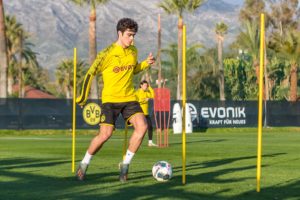
Not just since his performances in the Bundesliga and champions League, several nations wanted to convince Reyna to play for their country, Reyna raised interest outside the US. Portugal and Argentina threw their hats in the ring. It was his Portuguese passport that allowed the move to Europe after turning 16 in the first place–similarly to Reyna’s compatriot and BvB’s former player Christian Pulisic. Hence, in the summer 2019 he decided to join Dortmund’s U19. It came on the heels of Reyna scoring the game-winner in UEFA Youth League fixture against FC Barcelona. However, not many people would have imagined that he would play such a role in the first team after just seven months upon his arrival. Indeed, his gained status is reflected in his latest performances.
First footsteps on elite level in Champions League knock-out stage
“In training you can see that he has something special. If you can’t see that, you’re blind.” – Lucien Favre
Lucien Favre
A first key moment in Reyna’s recent raising happened on February 17th in Dortmund’s champions league game against PSG. With a score line of 1-0, Reyna was coming on as substitute for Hazard in the 67th minute. It was a phase of the game that could make or break their champions-league season –and Reyna took a central role. Not much time went by before Mbappé passed by Reyna and Zagadou easily to assist the 1-1. Two minutes later, the American actively demanded the ball from Hummels and brought the ball to Haaland who scored the game’s winner. With his performance he brought himself in position for future appearances. Recognizing Reyna’s talent is one thing, trusting him in a key phase of the season is another.
Why did Favre substitute Reyna in this critical situation of the game? If we want to understand his decent and recent performances, we can identify three key strengths that characterize Reyna’s game. The first two relate to rather overarching strengths that incorporate various individual skills. First, his understanding and anticipation of game situations and second, his sense and use of dynamics and spaces. The third strength is more straightforward and can be observed more directly, namely his pressing resistance. In turn, we can see room for improvement relating to his physical power and robustness as well as intensity in defense transitions.
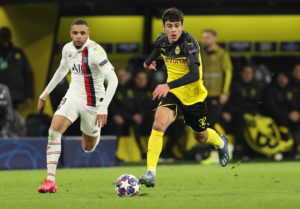
Understanding game situations and exploring opportunities others don’t see
First, Reyna’s performances are characterized by a great level of playing intelligence. Admittedly, the term playing intelligence is applied in a wide array of situations and has not one specific meaning. So, what does it mean in the context of his performances? Reyna’s football intelligence is among others reflected in his outstanding understanding of game situations. He is great at finding the right moment to hold or pass the ball. He moves into spaces intelligently, allowing him to exploit an advantageous starting position for his following action.
For instance, before he assisted the second goal against PSG (see graph 1), he moved in the right half-space. There he was in a position to receive the ball with enough distance to his opponents to turn around and have the game in front of him. This scene is remarkable because Reyna seems to be the only player seeing the opportunity presented–in contrast to PSG players Kurzawa and Verratti who react too late once he has received the ball. After exploiting the space between PSG’s midfield line, he plays a perfectly-weighted passes to Haaland–a pass with just the right speed, touch, and direction to give the receiver the best possible opportunity to do something positive with the ball the potential to attack the opponent defense line after just one turn with ball.
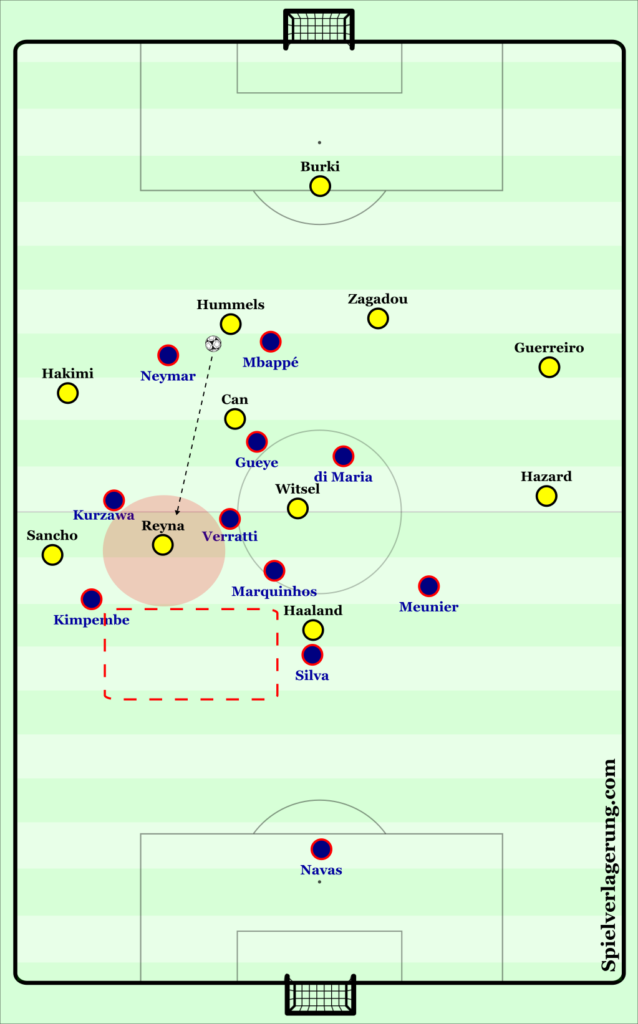
The young American repeatedly showed such great timing and decision-making. In general, he assesses situation in very interesting ways. Besides the PSG-game example, let’s look at the situation when he opened his BVB account by scoring a beautiful goal in the DFB-cup in Dortmund’s 3-2 defeat against Werder Bremen (see graph 2). There he had a wide range of opportunities, such as passing the ball to Schulz on the open left wing. However, he decided to move to the centre and shoot. In hindsight, one can easily say that he made the right decision, but in this situation, it was not the most obvious solution–especially for a player at his age from whom it is not expected to create such a potentially game-decisive situation. Hence, a second aspect in this first bucket of understanding game situation is his great recognition and assessment of his own abilities.
In the situation against Bremen he did not look for a good choice but exploited an opportunity from a relatively narrow space. As he attracted Osako, Bittencourt and Klaassen he was able to increase the space behind them, because these three Werder players stepped a few steps forward attacking Reyna. This might seem marginal, but in this situation helped to increase the space and hence the time Reyna had available after passing the opponent and just before shooting. In this context it will be interesting to see how Reyna evolves once opponent teams identify the potential threat and gets offered even less space and increase doublings. One factor that might play a central role is that he can judge precisely his own ability to pick up speed. And this sense for spaces and dynamics brings us to his second key strength.
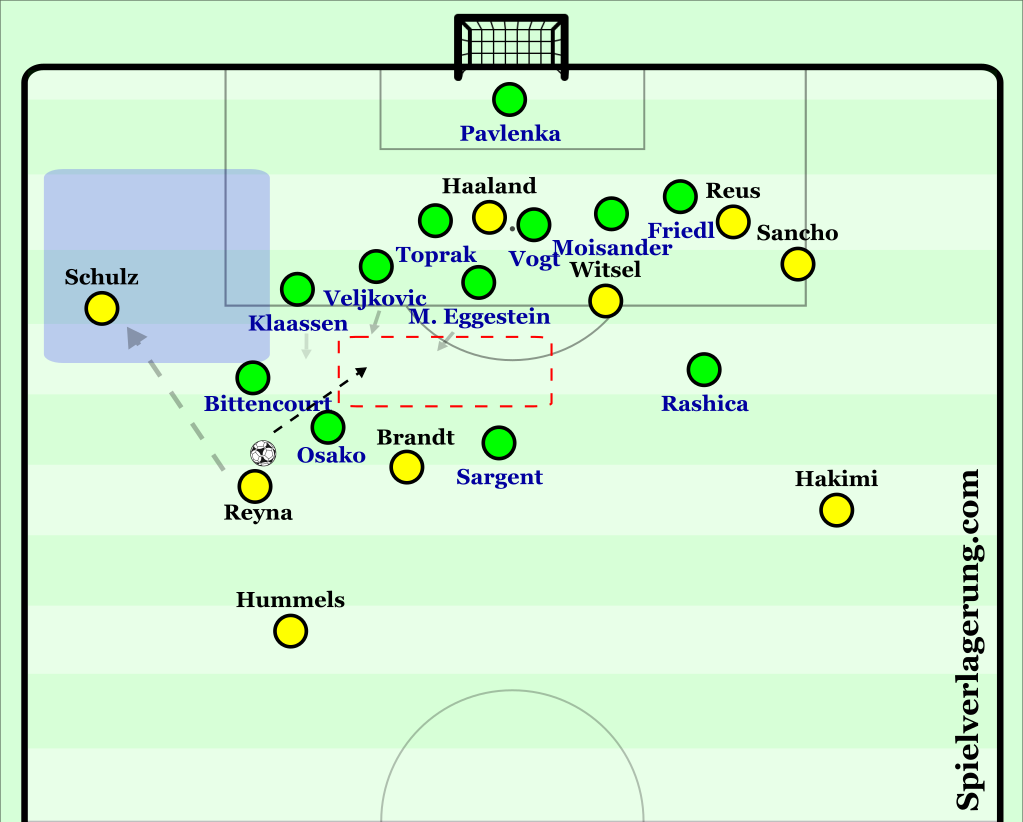
Bringing speed to action: leveraging a sense for dynamics and spaces
Everyone who has seen Reyna play, recognizes his great level of speed. However, is his speed and agility something that sets him apart from many others? In fact, one of his key strengths is not his mere speed, but how he leverages his dynamics on the pitch to solve the game situations he is involved in. Above we saw that Reyna judges situations with better info on his own strengths and following options. What is equally relevant is how he takes the speed of the ball in his own movement. The American can apply this strength in both dynamic and static situations. On the one side he understands it perfectly to not just save the ball but keep up the dynamic of situations. Reyna is very good at translating speed into subsequent actions even with the back to the open field. On the other side he can bring pace to the pitch even from a rather static position.
A perfect example offers the abovementioned situation in the PSG-match (see graph 1). He received the ball, gathered pace and brought the ball to Haaland in a favourable position to attack the goal. Certainly, this is a skill with has become increasingly important. For instances, especially in the Bundesliga most teams usually perform a good job at closing or minimizing zones for the opponent’s offense. Several opponents of dominant teams such as Bayern Munich and Borussia Dortmund face them in deeper positions, offering few spaces between their lines. In this light, the ability to create dynamics is of imminent importance to crack structured defense lines. Reyna is a player who can just do that. In the situation against Bremen the shoot itself was surely remarkable. Still, Reyna revealed more about his abilities by getting in the position for this shoot.
His ability to create dynamic from a rather standing position is based on many different skills that come together: his ability to keep the ball close while moving it forward, his dribbling, coordination skills and perception. In the stated situation this skillset helps him to get past three players within a relatively narrow space. In fact, you have to research for longer time to find such scenes even on this level. Sure, we know several other players which are great in rather tiny spaces such as his team-mate Mario Gotze. However, a scene in which a player creates dynamic from such a position which ends in a goal by applying such a variety of skills is outstanding and rare to find. This utterly outstanding goal against Werder Bremen bring a third key strength.
Resistant to opponent’s pressing pressure
A further key strength that characterize his performances is his pressing resistance. Reyna has shown to keep the ball even in situations facing great pressure from several opponent players. Marquinhos and Meunier already experienced that it is no easy job to steal the ball from Reyna. With his technique and perception, he’s able to dribble quite accurately in spaces. As indicated above, even in such situations he does not only look for the easy option to safe the ball, but still tries to bring the team in a better strategical position than it was before he received the ball. Considering this line of thinking and playing, he is often involved in situations that lead to goals or opportunities to score–maybe not always directly via a goal or assists but in the actions immediately preceding. Obviously, this strength also roots in his perception of game situations that we saw above.
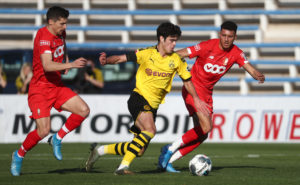
His high level of understanding and perception of the space is retained despite the pressure and enables him to better avoid opposition challenges. While maintaining control over the ball with apparent ease, Reyna varies between short touches, short ball transmissions or longer actions. The midfielder seems to precisely know the position of team mates and opponents, and gaps in the surrounding area. That being said, Reyna is much better equipped to dodge oncoming challengers and then to move the ball into any gaps opened by the pressing opponent.
Summarizing, his combination of strengths allows him to create spaces and dynamics, make few errors and bring in a surprising element. When he is involved, his action seems to contribute to the game of his team. Either he brings the ball in a more forward position and closer to dangerous zones. Or he enters a tiny space–attracting opponents to move in this very space–to open the field for team mates, e.g. through a short touch after receiving a pass. Such situations are often overlooked when concentrating on the bigger game or spectacular scenes including goals and assists. However, the consistency in which Reyna enhances his team’s ball possession and positioning by opening spaces and bringing the ball to more favourable positions is remarkable. Having said all of that, it’s no wonder that Reyna’s first ad campaign corresponds to his ability to find great and less obvious solutions. This campaign with Adidas focused on creativity, presenting him as part of the solution in reviving U.S. football after the World Cup 2018 qualifying failure.
Challenges ahead: room for improvement
Given his recent debut and considering his age, Reyna has a long journey ahead of him. Obviously, he just gave a short glimpse of his skills. To assess to what extent his solid performances were based on a fearlessness of youth still needs to be seen. After confirming his first great impression, the American needs to bring his strengths consistently on the pitch. Besides such consistency, Reyna surely provides room for improvements in certain areas.
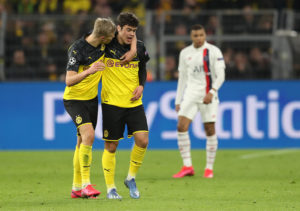
First, naturally given his age his development requires further development of his physical power. Several situations revealed that he seemed to lack the physical stature to screen the ball or position the body between the ball and the opponent. For instance, in DFB-cup game against Bremen he did not make the most out of two situations. In one he was appeared free before Pavlenka, but got pressure from a central defender. In another situation he went to the ground, rising discussions for a possible penalty. Nevertheless, he went to the ground and lost the ball. This point also became clear when he was beaten easily by Mbappé before the 1-1 assist, a scene mentioned above.
Clearly, in situations in which he has or gets challenged directly for the ball, Reyna could benefit from a greater robustness in using his body to protect the ball. In a similar vein, a second area of improvement seems to be his intensity when it comes to his behavior in defense. While he certainly shows good movements and runs, his intensity is not always great to support his team mates once the ball has passed his line. Especially, when he seems not to be directly involved, e.g. on the opposite side of the game. In such scenes he does not seem behave proactively enough to close gaps or position himself promisingly for second balls.
Scenes that indicate this aspect could be observed in game in the Bundesliga against Werder Bremen and against Bayer Leverkusen in February, e.g. right before Leverkusen equalized for 2-2 and 3-3 respectively. These scenes show what Reyna did not do when it comes to defensive behavior. And football is often not about what players do, but also what they don’t and could have done. And in these scenes, Reyna could have provided greater value for his colors. However, we don’t know Reyna’s instructions by Favre and how he was embedded in the structural corset of the black-and-yellows. If he was supposed to position higher, this point must be reconsidered in the new context. Overall, these scenes do not provide clear mistakes but rather room for improvement.
Conclusion and Outlook
“Gio in the starting 11? Why not? He has so much versatility and can play in many different positions.” – Lucien Favre
Reyna has set food on the elite level in an inexorable pace at a rather unusual point of the season. He entered the pitch in several critical game phases rather than being allowed to adapt slowly in the last minutes of games with clear score lines. Elusive footwork, effusive confidence and fearlessness of youth are key traits. On the pitch, Reyna’s ability to recognize game situations, read and anticipate the subsequent dynamics stand out. This make him good at exploiting tiny spaces. This make him good at initiating good actions after he received the ball. He often has one or two touches but develops the situation by getting the ball past several opponents or by bringing the ball to one of his team mates in a favourable position.
In other words, this ability to create a real value rather than merely participating at this level without harming through unnecessary errors is outstanding–and most likely one of the reasons why Reyna gets substituted in critical times of even more critical games. In knock-out games against PSG and Werder Bremen and against the key competitors in the Bundesliga Bayer Leverkusen and Borussia M’Gladbach. However, so far we have only seen Reyna in eight appearances. It will be interesting so see how he evolves on a mental level, for instance when starting a game and in general how he deals with rising expectations.
Currently, the position on the wings seems appropriate for his ability and his experience. There he can leverage his dribbling and pace-creating skills. In Dortmund’s 3-4-2-1 system he can also flexibly move in the half space and apply his skills in these zones that fit to his wide repertoire of skills. Hence, he can occasionally move towards the centre to participate in short combinations with increasing playing time Reyna could to a greater extent in Dortmund’s build up to a greater extent. For instance, from a higher position in the half spaces, he could drop deeper and open the field with a dynamic action. Similar plays can be observed with Jadon Sancho (whereas this idea occurs often too isolated and without strategically intent to stimulate further actions).
Furthermore, given Reyna’s strength in holding the ball, his technical skills and playing intelligence, one can imagine that he could also thrive in deeper positions in midfield. In fact, his team Dortmund is not great in build-up against and deeply positioned opponent. Hence, the build-up phase might be something Reyna can contribute to from a position in the first midfield line. Obviously, this decision will also depend on the further squad dynamics. On the one side, Dortmund has recently improved his defensive stability significantly with Can and Witsel on the double 6. On the other side, the squad might change over the summer with rumours ranking among Jadon Sancho most prominently. It is not unlikely, that Reyna could make huge steps towards a starting position after a departure of a prominent name. Similar scenarios played out in Dortmund, when Dembele left and Christian Pulisic and Jadon Sancho assumed more prominent roles and more playing time. Despite all this, we can be excited to see how Reyna’s footprint on Dortmund’s game will evolve over the coming time.
Writing by Tobias Meyer; Editing by Constantin Eckner.
1 Kommentar Alle anzeigen
Joshua DeAngulo March 31, 2020 um 6:12 pm
Kai Havertz 2.0